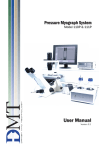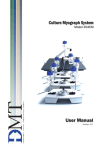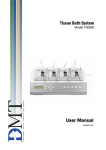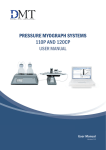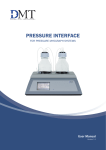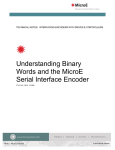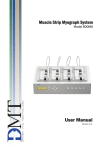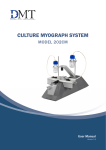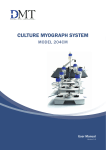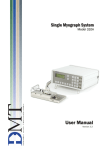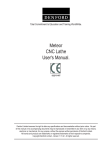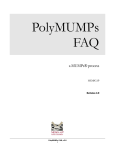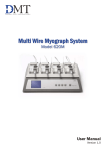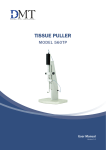Download User Manual
Transcript
Confocal Pressure Myograph System Model 120CP User Manual Version 3.2 Confocal Pressure Myograph System Model 120CP Pressure Myograph Systems - Model 120CP User Manual Trademarks Pentium is a registered trademark of the Intel Corporation. Windows, Windows 95, Windows 98, Windows ME, Windows NT, Windows 2000 and Windows XP are registered trademarks of Microsoft Corporation. All other trademarks are the properties of their respective owners. DMT reserves the right to alter specifications as required. This document was, as far as possible, accurate at the time of printing. Changes may have been made to the software and hardware it describes since then. New information may be supplied separately. This documentation is provided with the DMT Confocal Pressure Myograph Systems – Model 120CP – Version 3.2 Document Number: 120CP - 001A No part of this document may be reproduced by any means without the prior written permission of DMT. Copyright © 2006 DMT A/S DMT A/S Skejbyparken 152 DK-8200 Aarhus N Denmark Tel.: +45 87 41 11 00 Fax: +45 87 41 11 01 www.dmt.dk [email protected] or [email protected] DMT - Asia Everwin Gardens Rm 502, Block B 521 Wanping Nan Lu Shanghai 200030 China Tel: + 86 (0) 21 64869685 Fax: + 86 (0) 21 64280591 [email protected] [email protected] DMT-USA, Inc. 420 Beach Rd. #204 Sarasota, FL. 34242 USA Tel.: +1 770 612 8014 Fax: +1 678 302 7013 www.dmt-usa.com [email protected] or [email protected] User Manual vers. 3.2 Trademarks Introduction The confocal pressure myograph is a system specifically for use with laser scanning microscopes (LSM) and other high magnification imaging studies where intracellular processes within the smooth muscle cells or endothelial cells of the intact pressurized vessel wall are studied. Intracellular ion concentration such as calcium and trafficking of fluorescent probes tags or proteins can be studied in this system in small vessels (diameter >60µm). The conical open bath design allows easy access for high magnification/high numerical aperture lenses used in inverted microscopes. It also allows access for direct immersion lenses used in upright confocal microscopy. Further the top part of the myograph can be tipped, which facilitates maintenance and eases the mounting procedure. Using angled custom mounting supports designed specifically to allow very precise vertical positioning, an isolated blood vessel can be positioned directly above or on top of the chamber window permitting use of lenses with working distances as low as 100µm on an inverted LSM. The intravascular pressure and the pressure gradient along the vessel can be controlled precisely, and longitudinal force in the segment is measured continuously. A heating system with electronic feedback maintains bath temperature above ambient temperature. The customized chamber cover includes ports for superfusion, for rapid draining and filling and for gas supply. To facilitate cleaning, the chamber is made in stainless steel and is acid-resistant. When using the myograph on a confocal microscope, data acquisition is possible of in- and outlet pressure, force and temperature. Using the analogue outputs or the serial interface does it either. Confocal Pressure Myograph System Model 120 CP Safety The Confocal Pressure Myograph System has been designed for use only in teaching and research applications. It is not intended for clinical or critical life-care use and should never be used for these purposes: nor for the prevention, diagnosis, curing, treatment, or alleviation of disease, injury, or handicap. • Do not open the unit: the internal electronics pose a risk of electric shock. • Do not use this apparatus near water. • To reduce the risk of fire or electric shock, do not expose this apparatus to rain or moisture. Objects filled with liquids should not be placed on the apparatus. • Do not block any ventilation openings. Install in accordance with the manufacturer's instructions. • Do not install near any heat sources such as radiators, heat registers, stoves, or other apparatus that produce heat. • Only use attachments and accessories specified by the manufacturer. • Unplug this apparatus during lightning storms or when unused for long periods of time. • This apparatus must be grounded. • Use a three-wire grounding-type cord similar to the one supplied with the product. • Do not defeat the safety purpose of the polarized or grounding-type plug. A polarized plug has two flat blades, one being wider than the other. A grounding type plug has two blades and a third (round) grounding pin. The wide blade or the third prong is provided for your safety. If the provided plug does not fit into your outlet, consult an electrician for replacement of the obsolete outlet. • Be advised that different operating voltages require the use of different types of line cord and attachment plugs. Check the voltage in your area and use the correct type. See the table below: Voltage Line plug according to standard 110–125 V UL817 and CSA C22.2 No. 42. 220–230 V CEE 7 page VII, SR section 107-2-D1/IEC 83, page C4. 240 V BS 1363 of 1984. Specification for 13A fused plugs and switched and unswitched socket outlets. Protect the power cord from being walked on or pinched: particularly at power plugs and the point where they connect to the apparatus. Refer all servicing to qualified service personnel. Servicing is required when the apparatus has been damaged in any way; such as, the power-supply cord or plug is damaged, liquid has spilled onto or objects have fallen into the apparatus, the apparatus has been exposed to rain or moisture, does not operate normally, or has been dropped. User Manual vers. 3.2 Safety EMC / EMI This equipment has been tested and found to comply with the limits for a Class B Digital device, pursuant to part 15 of the FCC rules. These limits are designed to provide reasonable protection against harmful interference in residential installations. This equipment generates, uses and can radiate radio frequency energy and, if not installed and used in accordance with the instructions, may cause harmful interference to radio communications. However, there is no guarantee that interference will not occur in a particular installation. If this equipment does cause harmful interference to radio or television reception (which can be determined by monitoring the interference while turning the equipment off and on), the user is encouraged to correct the interference by one or more of the following measures: • Reorient or relocate the receiving antenna. • Increase the separation between the equipment and receiver. • Connect the equipment into an outlet on a circuit different to that which the receiver is connected to. • Consult the dealer or an experienced radio/TV technician for help. Approvals Complies with the EMC standards: EMC 89/336/EEC: EN 50 081-1 and EN 50 082-1 FCC part 15, Class B CISPR 22, Class B Certified with the safety standards: EN 60 065 (IEC 60065) Complies with the safety standards: UL6500 CSA E65 Confocal Pressure Myograph System Model 120CP Certificate of Conformity DMT A/S, Skejbyparken 152, 8200 Aarhus N., Denmark, hereby declares its responsibility that the following product: Confocal Pressure Myograph System Model 120 CP Version 3.2 is covered by this certificate and marked with CE-label conforms with the following standards: EN 60 065 (IEC 65) Safety requirements for mains operated Electronic and related apparatus for household and similar general use. EN 50 081-1 Electromagnetic compatibility – Generic emission standard Part 1: Residential, commercial and light industry. EN 50 082-1 Electromagnetic compatibility – Generic immunity standard Part 1: Residential, commercial and light industry. With reference to regulations in the following directives: 73/23/EEC, 89/336/EEC User Manual vers. 3.2 Certificate of Conformity Contents Trademarks ���������������������������������������������������������������������������������������������������������3 Introduction���������������������������������������������������������������������������������������������������������4 Safety�������������������������������������������������������������������������������������������������������������������5 EMC / EMI�����������������������������������������������������������������������������������������������������������6 Approvals�������������������������������������������������������������������������������������������������������������6 Certificate of Conformity������������������������������������������������������������������������������������7 About this Manual��������������������������������������������������������������������������������������������10 Unpacking the myograph system������������������������������������������������������������������� 11 Chapter 1 - System Overview�������������������������������������������������������������������������� 12 1.1 Confocal Pressure Myograph Unit���������������������������������������������������������������������������� 12 1.2 Pressure Myo-Interface��������������������������������������������������������������������������������������������� 13 1.3 Pressure Regulator���������������������������������������������������������������������������������������������������� 14 Chapter 2 - Setting up������������������������������������������������������������������������������������� 15 2.1 Confocal Pressure Myograph System – Model 120CP������������������������������������������� 15 2.2 Setting up Step by Step �������������������������������������������������������������������������������������������� 16 2.2.1 Setting up the Complete Confocal Pressure Myograph System�������������������������� 16 2.3 Experiment Setup������������������������������������������������������������������������������������������������������ 18 2.3.1 The First Weight and Pressure Calibrations��������������������������������������������������������� 18 2.3.2 External Confocal Pressure Myograph Unit Connections������������������������������������ 18 2.3.2.1 Connecting Perfusion Flow��������������������������������������������������������������������������������� 18 2.3.2.2 Extra Perfusion In/Outlet����������������������������������������������������������������������������������� 19 2.3.2.3 Connecting Superfusion Flow (Optional)����������������������������������������������������������� 19 2.3.2.4 Connecting Flowmeter – Model 161FM (Optional)������������������������������������������ 19 2.3.2.5 Connecting Oxygen Supply��������������������������������������������������������������������������������� 20 2.3.2.6 Connecting Suction Device�������������������������������������������������������������������������������� 20 Chapter 3 - The Pressure Myo-Interface���������������������������������������������������������21 3.1 Myo-Interface Manual����������������������������������������������������������������������������������������������� 21 3.1.1 General Key Functions������������������������������������������������������������������������������������������� 22 3.1.2 Turn-on Message���������������������������������������������������������������������������������������������������� 22 3.1.3 Main Menu�������������������������������������������������������������������������������������������������������������� 22 3.1.4 Pressure Menu������������������������������������������������������������������������������������������������������� 23 3.1.5 Recorder Menu������������������������������������������������������������������������������������������������������� 24 3.1.6 Setup Menu������������������������������������������������������������������������������������������������������������ 25 Chapter 4 - Pressure Myograph Manual�������������������������������������������������������� 28 4.1 The Pressure Myograph Unit������������������������������������������������������������������������������������� 28 4.1.1 Adjustment of Glass Cannulas������������������������������������������������������������������������������ 28 4.1.2 3-Way Valve Adjustments��������������������������������������������������������������������������������������� 29 4.1.3 How to Read a Millimetre Micrometer������������������������������������������������������������������ 30 4.1.4 Force and Pressure Calibration����������������������������������������������������������������������������� 31 4.1.4.1 Principles of Weight Calibration������������������������������������������������������������������������� 31 4.1.4.2 Weight Calibration Procedure���������������������������������������������������������������������������� 33 4.1.4.3 Pressure Calibration Procedure������������������������������������������������������������������������� 34 4.1.5 Replacement of Glass Cannulas��������������������������������������������������������������������������� 36 4.1.6 Checking the Force Transducer����������������������������������������������������������������������������� 37 4.1.6.1 Simple Force Transducer Check������������������������������������������������������������������������� 37 4.1.7 Checking the Pressure Transducers��������������������������������������������������������������������� 37 4.1.7.1 Simple Pressure Transducer Check������������������������������������������������������������������� 38 4.2 The Pressure Regulator��������������������������������������������������������������������������������������������� 38 4.2.1 Control of Flow and Pressure Settings������������������������������������������������������������������ 38 4.2.2 No-Flow Setting������������������������������������������������������������������������������������������������������ 38 Confocal Pressure Myograph System Model 120CP 4.2.3 Pressure Transducer Calibration��������������������������������������������������������������������������� 40 4.3 Pressure Myograph Maintenance and Cleaning����������������������������������������������������� 40 4.3.1 Pressure Myograph Chamber Pipes��������������������������������������������������������������������� 40 4.3.2 Force Transducer���������������������������������������������������������������������������������������������������� 40 4.3.3 Pressure Transducer and Glass Cannulas����������������������������������������������������������� 41 5.3.4 Pressure Regulator Cleaning��������������������������������������������������������������������������������� 41 4.3.5 Cleaning Pressure Myograph Chamber���������������������������������������������������������������� 42 Chapter 5 - Myograph Accessories and Spare Parts������������������������������������ 44 5.1 General Myograph Equipment���������������������������������������������������������������������������������� 44 5.2 Pressure Myograph System Accessories����������������������������������������������������������������� 44 5.3 Pressure Myograph System Spare Parts����������������������������������������������������������������� 45 Chapter 6 - Getting Started���������������������������������������������������������������������������� 46 6.1 Dissection Protocol for Small Mesenteric Arteries�������������������������������������������������� 46 6.2 Mounting Protocol for Small Arteries����������������������������������������������������������������������� 49 Appendix 1 - Terms of Warranty���������������������������������������������������������������������� 53 Appendix 2 - Service Check���������������������������������������������������������������������������� 54 Appendix 3 - Shipping Instructions���������������������������������������������������������������� 55 Appendix 4 - Calibration of Eyepiece Reticule���������������������������������������������� 56 Appendix 5 - System Specifications �������������������������������������������������������������� 58 Appendix 6 - Fuse Changing��������������������������������������������������������������������������� 59 User Manual vers. 3.2 Contents About this manual This manual contains a complete list of procedures describing how to install, maintain and get started using the Confocal Pressure Myograph System – Model 120CP – Version 3.2 Chapter 1 provides an overview of the construction and basic features of the complete Confocal Pressure Myograph System. Chapter 2 describes step by step how to set up a complete Confocal Pressure Myograph System. Chapter 3 is a complete manual to the Myo-Interface. The chapter describes in detail the construction of the menu system and how to use all the features of the Confocal Pressure Myograph System. Chapter 4 is a complete manual to the Confocal Pressure Myograph System. The chapter describes in detail how to use and adjust the Confocal Pressure Myograph chamber and finally instructions to daily maintenance of the Confocal Pressure Myograph System. Chapter 5 is a list of equipment needed to set up a complete Confocal Pressure Myograph System. The chapter also contains a list of accessories and spare parts available to the Confocal Pressure Myograph System – Model 120CP. Chapter 6 contain procedures describing how to get started using the Confocal Pressure Myograph System. This includes a complete dissection and mounting procedure. Appendices contain additional information about myograph service, shipping instructions, system specifications, serial protocol and fuse changing. 10 Confocal Pressure Myograph System Model 120CP Unpacking the myograph system Please take a few minutes to carefully inspect your new Confocal Pressure Myograph System for damage, which may have occurred during handling and shipping. If you suspect any kind of damage, please contact us immediately and the matter will be pursued as soon as possible. If the packing material appears damaged, please retain it until a possible claim has been settled. We recommend that you store the packing material for any possible future transport of the Confocal Pressure Myograph System. In case of transport and the original packing material is unavailable, please contact DMT Sales Department for advice and packing instructions. After unpacking your new Confocal Pressure Myograph System, please use the following list to check that the system is complete: 1. Confocal Pressure Myograph Unit: • Force calibration kit (Including “bridge”, “balance” and 2 gram weight) • Resistance tube shunt (Calibration tube) • Two glass cannulas • Chamber cover 2. Pressure Myo-Interface: • Pressure Myograph Unit connection cable with a temperature probe • Power cord (the shape of the AC plug varies by country; be sure that the plug has the right shape for your location) • Serial Cables for PC connection or serial connection to other DMT Pressure Myograph Systems 3. Pressure Regulator: • Power cord (the shape of the AC plug varies by country; be sure that the plug has the right shape for your location) • Atlas Copco Cablair hose for main pressure supply • Two 500ml Schott Duran Bottles incl. special designed screw caps 4. Riester “Big Ben” Pressure Manometer: 5. Accessories: • Allen key • Spare screws • Small screwdriver • Suture nylon wire, 3 metres • 1 tube of high vacuum grease • 1 tube of grease for linear slides • Silicone tubing, internal diameter 1mm, 25 metres 6. Hardware, Software & Manuals: • User manual “Confocal Pressure Myograph System – Model 120CP” • Cleaning Procedure User Manual vers. 3.2 Unpacking the myograph system 11 Chapter 1 - System Overview 1.1 Confocal Pressure Myograph Unit Horizontal Adjustment Screws Perfusion Inlet Pipe Outlet Pressure Transducer Connection Pipe Inlet Valve 25 Pin Serial Port for Communication with Myo-Interface Outlet Valve Micropositioner for Vertical Adjustment of Glass Cannulas Force Transducer Pin Fixation Plate for left Glass Cannula Outlet Connecting Pipe Fixation Plate for Right Glass Cannula Silicone Tube connecting ‘Perfusion Inlet Pipe’ and Right Glass Cannula Silicone Tube connecting ‘Outlet Connecting Pipe’ with Left Glass Cannula Left Glass Cannula Right Glass Cannula Myo Chamber Window Figure 1.1 The Confocal Pressure Myograph Chamber 12 Confocal Pressure Myograph System Model 120 CP 1.2 Pressure Myo-Interface Up and Down Arrow Keys - Scroll up and Analogue Recorder Output - Connection to down in the menus. If you are at the top of a menu, use ↑ to change to the previous main menu. external data acquisition system (optional). Myo-Interface Display MYO INTERFACE MODEL 120CP VERSION 3.2 F1 F2 F3 F4 Info Esc Enter 1 2 3 Rec. 1 4 5 6 Rec. 2 7 8 9 Rec. 3 - 0 . Rec. 4 Numeric Keys - Enter data or setting values F-Keys - Have different but specific functions dependent of the active main menu. Enter Key - Confirm entered numeric val- INFO Key - Push this key in any menu ues or change between available choices. to display all specific F-key functions. ESC Key - Delete incorrectly entered numeric values. In some submenus used to return to main menu. Figure 1.2 Pressure Myo-Interface Front 115-230 V / 50-60 Hz Automatic Voltage Selector ON/OFF Switch Power Connector O I USB REGULATOR RS232 Connection Port for control of Pressure Regulator ON 12V DC 1 2 pH MYOGRAPH Connection Port for Pressure Myograph Unit RS 232 Port for Serial Connection to PC Connection Port for pH-Meter (optional) USB Port Figure 1.3 Pressure Myo-Interface Back 12V DC Port User Manual vers. 3.2 Chapter 1 13 1.3 Pressure Regulator Pressure and Perfusion Buffer Inlet and Outlet pipes Calibration Valve V1 V2 V3 V4 NO FLOW Pressure Transducer Calibration Valve Pressure Valve Activity Indicators Figure 1.4 Pressure Regulator Front Main Pressure Inlet 115-230 V/50-60 Hz Automatic Voltage Selector Connection Port for the Pressure Myo-Interface 230V Interface O I Pressure inlet ON/OFF Switch Inlet Pressure Manometer Power Connector Figure 1.5 Pressure Regulator Back 14 Confocal Pressure Myograph System Model 120CP Chapter 2 - Setting up 2.1 Confocal Pressure Myograph System – Model 120CP Myo-Interface Rear Panel pH-Meter (optional) Peristaltic Pump (optional) Connection Cable with temperature probe PC Data Acquisition and Sofware (Optional for 120CP) Serial/USB Cable RS 232/USB Pressure and Oxygen Supply FlowMeter 161FM (optional) fe Buf ion fus Per r Ou w tflo flow r In uffe nB io s u f Per DMT Microscope Oxygen Superfusion Supply Buffer Vaccum Pump Sucction Bottle Waste Bottle Outlet Inlet Pressure Regulator Rear Panel Figure 2.1 The Complete Confocal Pressure Myograph System - Model 120CP Fig. 2.1 is a diagram of the complete set-up for the Confocal Pressure Myograph System Model 120CP. The diagram includes optional equipment as a peristaltic pump to enable superfusion flow and pH probes for measuring pH in the superfusion buffer. Also the diagram include the DMT Flowmeter Model 161FM. The Flowmeter enables flow measurements in the range of 15-1500μl/min. Contact the DMT Sales Department for further product information and prices on any of the optional products shown in fig. 2.1 User Manual vers. 3.2 Chapter 2 15 2.2 Setting up Step by Step Note: If you have purchased a computer from DMT in conjunction with your Confocal Pressure Myograph System the Euresys Picolo frame grabber PCI card has already been installed. Follow the procedures in sec. 2.2.1 to set-up the Confocal Pressure Myograph System. 2.2.1 Setting up the Complete Confocal Pressure Myograph System This section describes how to connect the cables in the Confocal Pressure Myograph System as illustrated in fig. 2.1. Note: Before proceeding with the connection procedure, make sure that the Myo-Interface; the Pressure Regulator, the Microscope and the PC are switched off. 1. Confocal Myograph Unit – Myo-Interface Connection: Connect the Confocal Pressure Myograph Unit to the Myo-Interface by using the grey 25-pin connection cable. The end of the cable with the temperature probe is used with the Confocal Pressure Myograph Unit. 2. Myo-Interface – Pressure Regulator Connection: Connect the Myo-Interface to the Pressure Regulator by using the grey 15-pin connection cable. Connect the power cord to the power inlet on the back panel of both the Myo-Interface and the Pressure Regulator. 3. Pressure Regulator – Oxygen Supply Connection: Connect the “Main Pressure Inlet” on the back panel of the Pressure Regulator to an adjustable oxygen supply using the “Atlas Copco Cablair hose” delivered with the Confocal Pressure Myograph System. Important Make sure that the hose is securely fastened to the “Main Pressure Inlet” using the hose clip. The pressure from the oxygen supply must not exceed 1.0 Bar! 4. Myo-Interface – External Data Acquisition System Connection (optional): The four BNC ports on the Myo-Interface front enables connection of an external data acquisition system for recording the inlet pressure, the outlet pressure, the longitudinal force, the actual temperature and the pH value of the superfusion or perfusion buffer. Note: Only four of the five data channels can be recorded simultaneously. 16 Confocal Pressure Myograph System Model 120CP 5. Turn on the Power: Turn the main power to the Myo-Interface and the Pressure Regulator on at the power switch and the Microscope. Turn on the computer and the Confocal Pressure Myograph System is now ready to be used . Note: A detailed guidance in how to connect the Confocal Pressure Myograph System for an experimental setup is described in detail in chapter 2.3, p. 20. User Manual vers. 3.2 Chapter 2 17 2.3 Experiment Setup 2.3.1 The First Weight and Pressure Calibrations Prior to the shipment of the Confocal Pressure Myograph System, it has gone through two days of continuous testing including final weight and pressure calibrations. However in order to ensure that the myograph is working at highest performance, DMT recommends that new weight and pressure calibrations are performed before starting to use the Confocal Pressure Myograph System. The weight and pressure calibration procedures are described in detail in Chapter 4.1.4, p. 31. 2.3.2 External Confocal Pressure Myograph Unit Connections This section describes how to connect the perfusion circuit, the superfusion circuit, oxygen supply, pressure supply and suction device. Perfusion outlet Extra perfusion outlet Suction pipe for connection to vacuum Superfusion inlet Superfusion outlet Pipe for connedction to oxygen supply Figure 2.3 External Pressure Myograph connection Perfusion inlet Access hole for Extra perfusion reagents, buffer, inlet temperature or pH probe 2.3.2.1 Connecting Perfusion Flow The perfusion flow is controlled by the Pressure Regulator via the Myo-Interface. How to control the perfusion flow is described in detail in chapter 3.1.4, p. 23. To connect the Pressure Regulator to the Confocal Pressure Myograph Unit use the silicone tube (internal diameter 1mm) delivered with the Confocal Pressure Myograph System. Connect the “perfusion inlet” at P1 on the Confocal Pressure Myograph Unit to the P1 outlet on the cap of the buffer bottle. Connect the “perfusion outlet” at P2 on the Confocal Pressure Myograph Unit to the P2 inlet in the Pressure Regulator Unit (see fig. 2.1, p. 15.) 18 Confocal Pressure Myograph System Model 120 CP Note I To fill the tubing and avoid air bubbles, mount the “Resistance tube shunt” as described in Chapter 4.1.4.3, p. 34. Fill the buffer bottle with 250ml buffer and run the following “flush” programme: P1 = 150 mm Hg P2 = 70 mm Hg Enter the pressure values in the “Pressure Menu” and press F2 in the “Main Menu” to start the “flush” programme. Run the programme until no air bubbles are visible in the perfusion circuit. Note II Never fill the buffer bottle with more than 250ml of buffer as higher volumes makes precise control of the pressure more difficult. Important Never run the “flush” programme with a vessel mounted in the Confocal Pressure Myograph Chamber as this may cause serious damage to the vessel. 2.3.2.2 Extra Perfusion In/Outlet The extra perfusion in and outlet on the Confocal Pressure Myograph Unit makes it possible to add special agents or reagents to the perfusion circuit during an experiment. The small handle on top of the valves controls the flow directions through the 3-way valves at P1 and P2 as described in Section 4.1.2, p. 29. 2.3.2.3 Connecting Superfusion Flow (Optional) Creating a superfusion flow in the Confocal Pressure Myograph Chamber requires an external peristaltic pump, which is not part of the standard Confocal Pressure Myograph System. Contact DMT for further information about recommended perfusion pump models, specifications and prices. The superfusion circuit is connected to the Confocal Pressure Myograph Unit as illustrated in fig. 2.1, p. 15. 2.3.2.4 Connecting Flowmeter – Model 161FM (Optional) The DMT Flowmeter – Model 161FM is optional for flow measurements in the range of 15 – 1500µl/min. The Flowmeter is easily combined with any DMT Pressure Myograph System as illustrated in fig. 2.1, p. 15. Use of the FlowMeter 161FM makes it possible to control intravascular pressure, pressure gradient and flow conditions with high accuracy, which enables the performance of in vitro studies on vessel segments under conditions very close to those found in vivo. Application of the FlowMeter 161FM also enables measurement of flow rate as a parameter due to changes in vessel structure and function in various physiological and pharmacological studies. The FlowMeter 161FM is supplied with MyoFlow, an add-on software programme for MyoView. Besides calculating the flow rate, MyoFlow enables real time calculations of total flow and current drop volume. In addition MyoFlow features a real time flow graph showing flow rate development over time. User Manual vers. 3.2 Chapter 2 19 2.3.2.5 Connecting Oxygen Supply Connect the “oxygen supply pipe” on the Confocal Pressure Myograph Chamber cover to an adjustable oxygen supply. 2.3.2.6 Connecting Suction Device Connect the “large” pipe on the Confocal Pressure Myograph Chamber cover (see fig. 2.3, p. 18) to a vacuum pump via a suction bottle and a vacuum valve as illustrated in fig. 2.1, p. 15. The internal diameter of the silicone tube used for this connection must be 2mm (A 2mm tube is not included in the myograph system). 20 Confocal Pressure Myograph System Model 120CP Chapter 3 - The Pressure Myo-Interface Chapter 3 is a complete manual for the Confocal Pressure Myo-Interface, version 3.2. The chapter contains a step-by-step description of how to navigate in the menus and how to use the special features of the Pressure Myograph System, like the sequencer program. 3.1 Myo-Interface Manual Fig. 3.1 is an overview of the menus in the Pressure Myo-Interface, version 3.2. The menus are divided into main menus and submenus. In the following sections, all menus are described in detail. Myo-Interface Model 120CP Version 3.2 F1 F1 -- Main Menu -P1. : 64.4 mm Hg P2. : 55.3 mm Hg Force : 10.15 mN Temp. : 26.5 ºC Set. Temp: 37.0 ºC Heat : on pH : 7.00 F1 F2 F3 F4 : : : : Info Change menu Start pres. Ctrl Zero force Condensed menu F4 Near Far Act.: 26.5 Heat: OFF F1 -- Pressure Menu -P1 Inlet : 90 mm Hg P2 Outlet : 80 mm Hg Status : OFF Flow : ON mm Hg/sec : 10 F1 F2 F3 F4 F1 -- Recorder Menu -Rec. 1 > Press. 1 Rec. 1 lo : 0 Rec. 1 hi : 200 Rec. 2 > Press. 2 Rec. 2 lo : 0 Rec. 2 hi : 200 Rec. 3 > Force Rec. 3 lo : 0 Rec. 3 hi : 100 Rec. 4 > Temp Rec. 4 lo : 0 Rec. 4 hi : 50 -- Setup Menu -Calibrate : Press Resovoir : 37°C Option : 0 F1 F2 F3 F4 Info : Change menu : : : Cal. pressure Info : Change menu : Start pres. Ctrl : : : 12.5mN : 2.7 mN Set: 37.0 pH: 7.00 -- Setup -Options Menus -- Setup -Options Menus No.7 -- Comm. Menu -Serial mode : RS485 Myograph : A No.7 -- pH. Menu -Offset buffer : 7.00 Slope buffer : 4.00 Temp. comp : Auto Manual temp. : 37°C F4 Calibrate Pressure Apply 50 mm Hg Push F3 when stable P1 3614 P2: 3533 F4 Calibrate Force Apply no Force Push F3 when stable Force: 1938 F3 Calibrate Pressure Apply 125 mm Hg Push F3 when stable P1 4252 P2: 4222 F3 Calibrate Force Place 2 g. on the pan Push F3 when stable Force: 2245 F3 Calibrate pH Slope Slope buffer : 4.00 Temp. (auto) : 22.4 °c pH output : 177mV F3 Calibrate Pressure Apply 200 mm Hg Push F3 when stable P1 4956 P2: 4933 F3 Calibrate Force DONE: Push Esc. Force Zero: 20315 Force gain: 668.3 F3 Calibrate pH OFFSET Offset : 2208 Slpoe : 26.4 F4 Calibrate pH OFFSET Offset buffer : 7.00 Temp. (auto) : 22.4°c pH output : 2mV F3 Calibrate Pressure DONE - Push Esc. 36148 42527 49565 35334 42223 49332 Figure 3.1 Menus in the 120CP Myo-Interface, version 3.2. User Manual vers. 3.2 Chapter 3 21 3.1.1 General Key Functions ↑ - ↓: Scroll up and down in the menus. Being in the top line of a menu, use ↑ to change to the previous main menus. Info: Push this key in any menu to display all specific F-key functions. Numeric keys: Enter data or setting values. Enter: Confirm entered numeric values or change between available choices. Esc: Delete incorrectly entered numeric values. In some submenus used to return to main menu. F1: Change to the next menu. F2 – F4: Have different but specific functions dependent of the active main menu. 3.1.2 Turn-on Message Turning on the Pressure Myo-Interface, a message appears as shown to the right. Use the ↑ and ↓ keys to adjust the display contrast setting. Myo-Interface Model 120CP Version 3.2 Press F1 for proceeding to the Main Menu. 3.1.3 Main Menu The Main Menu displays: P1: Inlet pressure reading in mm Hg P2: Outlet pressure reading in mm Hg Force: Longitudinal force reading in mN Temp.: Actual temperature probe reading in ºC Set temp: Heating temperature setting in ºC Heat: Actual heating status (ON/OFF) pH: Actual pH reading (Optional) -- Main Menu -P1. : 64.4 mm Hg P2. : 55.3 mm Hg Force : 10.15 mN Temp. : 26.5 ºC Set. Temp : 37.0 ºC Heat : on pH : 7.00 Use the ↑ and ↓ keys to see all values as the display is only capable of showing four lines at the time. Temperature setting: To change the temperature setting, move the “Set. Temp” line to the top of the display. Use the numeric keys to enter a new temperature setting and press Enter to confirm. Heating control: To turn on heating, move the “Heat” line to the top of the display and use Enter to switch between on and off. 22 Confocal Pressure Myograph System Model 120CP The Main Menu has the following functions: Info:Press the Info key and the display shows the F-key options in the “Main Menu”. Press Info again to return to the “Main Menu” or one of the F-keys to proceed with one of these options. F1 F2 F3 F4 : : : : Info Change menu Start pres. Ctrl Zero force Condensed menu F1: Press F1 to proceed to the “Pressure Menu”. F2: Press F2 to start the pressure control programme. The settings of the pressure control programme are adjusted in the Pressure Menu. F3: Press F3 to zero the longitudinal force reading. F4: Press F4 for the display to show a condensed “Main Menu”, showing pressure inlet reading (P1), pressure inlet setting (P1 set.), pressure outlet reading (P2), pressure outlet setting (P2 set.), force reading (F), pH reading, Temperature reading (T) and temperature setting (T set.) P1: 141 P2: 129 F : 10,1 T : 20.7 F4 P1 set: 140 P2 set: 130 T. set : 37 3.1.4 Pressure Menu The “Pressure Menu” displays: P1 Inlet: Inlet pressure setting in mm Hg P2 Outlet: Outlet pressure setting in mm Hg Status: Activation of pressure control (ON/OFF) Flow: Activation of flow control (ON/OFF) mm Hg/sec: Setting of pressure changing gradient -- Pressure Menu -P1 Inlet : 90 mm Hg P2 Outlet : 80 mm Hg Status : OFF Flow : ON mm Hg/sec : 10 The “Pressure Menu” enables control and adjustment of pressures and flow. P1 Inlet and P2 Outlet settings control the inlet and outlet pressure of the perfusion buffer. The pressure control is activated or deactivated in the Status line by choosing ON/OFF. User Manual vers. 3.2 Chapter 3 23 Important: Please note that the P1 inlet pressure cannot be smaller than the P2 outlet pressure. If a P1 value is entered, which is smaller than the P2 value, then the P1 value will automatically be set equal to the P2 value. Also if a P2 value is entered, which is larger than the P1 value, then the P2 value will automatically be set equal to the P1 value. A setting where P1 = P2 activates the “No-Flow” function in the Pressure Regulator as described in Chapter 4.2.2, p. 38 The function works to prevent backflow. The perfusion flow can be activated or deactivated in the Flow line (ON/OFF). In the mm Hg/sec line it is possible to adjust and control the pressure-changing gradient. The “Pressure Menu” has the following functions: Press the Info key and the display shows the F-key options in the “Pressure Menu”. Press Info again to return to the “Pressure Menu” or one of the F-keys to proceed with one of these options. F1: Press F1 to proceed to the “Sequencer Menu”. F2: Press F2 to start the pressure control programme. Info: F1 F2 F3 F4 Info : Change menu : Start pres. Ctrl : : 3.1.5 Recorder Menu The Pressure Myo-Interface has four analogue output ports at the front panel for connection to a data recording system. Each of these output ports can be programmed to represent inlet pressure reading, outlet pressure reading, longitudinal force reading, temperature or pH-meter. The default settings are: Rec. 1: Rec. 2: Rec. 3: Rec. 4: P1 Inlet pressure output P2 Outlet pressure output Longitudinal force output Temperature output The full-scale output on the recorder is one volt. In the “Recorder Menu” it is possible to change the value that corresponds to 0 V (lo) and 1 V (hi). 24 Confocal Pressure Myograph System Model 120CP -- Recorder Menu -Rec. 1 > Press. 1 Rec. 1 lo : 0 Rec. 1 hi : 200 Rec. 2 > Press. 2 Rec. 2 lo : 0 Rec. 2 hi : 200 Rec. 3 > Force Rec. 3 lo : 0 Rec. 3 hi : 100 Rec. 4 > Temp Rec. 4 lo : 0 Rec. 4 hi : 50 3.1.6 Setup Menu The “Setup Menu” displays: Calibrate: Reservoir: Option: Choose which sensor to be calibrated. (Pressure, force or pH) Temperature setting for perfusion buffer reservoir The option line allows access to submenus using special codes - Setup Menu -Calibrate : Press Resovoir : 37°C Option : 0 To change any of the settings in the “Setup Menu”, move the line to be changed to the top line of the display: • Press Enter to change between calibration of pressure transducers, force transducer or pH in the calibrate line. •Use the numeric keys to change the reservoir temperature setting and press Enter to confirm. •Enter the specific access code and press Enter to go to the submenu. The “Setup Menu” has the following functions: Info: Press the Info key and the display shows the F-key options in the “Setup Menu”. Press Info again to return to the “Setup Menu” or one of the F-keys to proceed with one of these options. F1: Press F1 to proceed to the “Main Menu”. F4: Pressure transducer calibration Choose Press in the calibrate line and press F4 to enter the window shown to the right. Apply a pressure of 50 mm Hg on the Pressure Myo graph using the “Big Ben” pressure manometer. When the relative readings at the bottom line of the window appears stable, press F3 to proceed. Apply a pressure of 125 mm Hg on the Pressure Myograph using the “Big Ben” pressure manometer. When the relative readings at the bottom line of the window appears stable, press F3 to proceed. Apply a pressure of 200 mm Hg on the Pressure Myograph using the “Big Ben” pressure manometer. When the relative readings at the bottom line of the window appears stable, press F3 to proceed. The calibration is now finished. The readings in the two bottom lines are the calibration parameters stored in the internal memory of the Myo-Interface. Press ESC to return to the “Setup Menu”. F1 F2 F3 F4 Info : Change menu : : : Cal. pressure F4 Calibrate Pressure Apply 50 mm Hg Push F3 when stable P1 3614 P2: 3533 F3 Calibrate Pressure Apply 125 mm Hg Push F3 when stable P1 4252 P2: 4222 F3 Calibrate Pressure Apply 200 mm Hg Push F3 when stable P1 4956 P2: 4933 F3 Calibrate Pressure DONE - Push Esc. 36148 42527 49565 35334 42223 49332 User Manual vers. 3.2 Chapter 3 25 For a more detailed instruction to the calibration procedure, see Chapter 4.1.4, p.31. Force transducer calibration Chose Force in the calibrate line and press F4 to enter the window shown to the right. Make sure that no force is applied on the force transducer and when the relative reading at the bottom line of the window appears stable, press F3 to proceed. Carefully place the 2-gram weight on the load pan and when the relative reading at the bottom line of the window appears stable, press F3 to proceed. The calibration is now finished. The readings in the two bottom lines are the calibration parameters stored in the internal memory of the Myo-Interface. Press ESC to return to the “Setup Menu”. F4 Calibrate Force Apply no Force Push F3 when stable Force: 1938 F3 Calibrate Force Place 2 g. on the pan Push F3 when stable Force: 2245 F3 Calibrate Force DONE: Push Esc. Force Zero: 20315 Force gain: 668.3 For a more detailed instruction to the calibration procedure, see Chapter 4.1.4, p.31. pH calibration (Optional) Choose pH in the calibrate line and press F4 to enter the window shown to the right. The first line shows the value of the offset buffer (first buffer solution), which is always 7.00. The second line shows the temperature of the buffer solution. The temperature is an important parameter in the calibration formula and is obtained automatically by placing the myograph temperature probe in the buffer solution. The third line shows the output from the pH probe as raw data from the A-D converter. Place the pH-meter electrode and temperature probe in the offset buffer solution and turn on stirring. When the relative pH output in the bottom line is stable, press F3 to proceed. In the first line is now shown the value of the slope buffer (second buffer solution), which is always 4.00. Place the pH and temperature probes in the slope buffer solution and turn on stirring. When the relative pH output in the bottom line is stable, press F3 to proceed. The calibration is now finished. The parameters are stored in the internal memory of the Myo-Interface. Press ESC to return to the “Setup Menu”. 26 Confocal Pressure Myograph System Model 120CP F4 Calibrate pH OFFSET Offset buffer : 7.00 Temp. (auto) : 22.4 °c pH output : 2mV F3 Calibrate pH Slope Slope buffer : 4.00 Temp. (auto) : 22.4 °c pH output : 177mV F3 Calibrate pH OFFSET Offset : 2208 Slpoe : 26.4 Special “Communication” submenu: To open the special “Communication” submenu, enter the code 7 in the option line in the “Setup Menu”. Serial mode: RS232 or RS485 serial communication setting Myograph: Myograph serial identification A, B, C or D No.7 -- Comm. Menu -Serial mode : RS485 Myograph : A In the “Serial mode” the serial communication can be chosen to be either RS232 or RS485. RS485 is used when more than one myograph is connected to the serial port on the same computer. Up to four myographs can be connected to the same computer but the connection requires a separate RS232/ RS485 converter. The “Myograph” line is only shown if the RS485 setting is chosen in the “Serial mode” line. The “Myograph” line is used to select the number for the individual myographs A, B, C or D. Press F1 to return to the “Setup Menu”. Special “pH” submenu: To open the special “pH” submenu, a special code is required. Please contact DMT for further information. Offset buffer: pH value of offset buffer Slope buffer: pH value of slope buffer Temp. comp: AUTO or MANUAL temperature compensation Manual temp: Manual temperature setting The pH submenu contains the settings of the pH calibration procedure. Offset buffer and slope buffer are the pH values of the buffers used to calibrate the pH probe. -- pH. Menu -Offset buffer : 7.00 Slope buffer : 4.00 Temp. comp : Auto Manual temp. : 37°C pH measurements are temperature dependent and in the “temperature compensation” line it is possible to choose between an AUTO or MANUAL temperature compensation. In the AUTO mode the temperature probe is used to measure the temperature of the calibration buffers. The temperature is then automatically used in the pH calibration. In the MANUAL mode, the temperature of the calibration buffers is measured with a thermometer and entered manually in the “manual temperature” line. Press F1 to return to the “Setup Menu”. User Manual vers. 3.2 Chapter 3 27 Chapter 4 - Pressure Myograph Manual Chapter 4 contains a complete explanation to all mechanical features of the Confocal Pressure Myograph System. This includes how to use, adjust and separate the Confocal Pressure Myograph Unit. 4.1 The Pressure Myograph Unit 4.1.1 Adjustment of Glass Cannulas Adjustment of the glass cannulas is divided into a pre-experimental alignment and general adjustments done during mounting of a blood vessel or when running an experiment. General Adjustments: General adjustments are performed using the two micropositioners on top of the Confocal Pressure Myograph Unit. The vertical micropositioner (fig. 4.1 B) is used to adjust the vertical position of the right glass cannula and thereby the vertical position of the mounted blood vessel. The horizontal micropositioner (fig. 4.1 C) is used to define the length between the two glass cannulas and thereby the horizontal stretch of the mounted blood vessel. B C A D E F G Figure 4.1 Adjustment of glass cannulas 28 Confocal Pressure Myograph System Model 120CP Pre-Experimental Alignment: To make the general adjustments as easy as possible during an experiment, it is important to make an alignment of the glass cannulas prior to the mounting of the blood vessel. Left Glass Cannula: Horizontal positioning of the left glass cannula is adjusted by carefully loosening screw D (fig. 4.1). Vertical positioning of the left glass cannula is adjusted by carefully loosening screw E (fig. 4.1). Longitudinal positioning of the left glass cannula is adjusted by gently loosening of screw F (fig. 4.1). Important Be very careful not to apply too much force (>100 gram) on the force transducer pin when adjusting the left glass cannula. The force transducer has a mechanical protection in its longitudinal direction of movement, but is very vulnerable to force applied on the force transducer pin. Right Glass Cannula: Horizontal positioning of the right glass cannula is adjusted by carefully loosening screw A (fig. 4.1). Vertical positioning of the right glass cannula is adjusted with the micropositioner C (fig. 4.1). Longitudinal positioning of the right glass cannula is adjusted by gently loosening of screw G (fig. 4.1). Note: Be careful not to damage the tip of the glass cannulas during the general adjustment. 4.1.2 3-Way Valve Adjustments The 3-way valves on each side of the Pressure Myograph Unit (at P1 & P2) have three different settings to control the in- or outlet flow to the pressure transducers. The flow settings are illustrated in fig. 4.2 and fig. 4.3. Figure 4.2 Three-way valve flow settings at P1 Figure 4.3 Three-way valve flow settings at P2 User Manual vers. 3.2 Chapter 4 29 4.1.3 How to Read a Millimetre Micrometer Sleeve Scale Timble Scale Figure 4.4 Overview of a Micrometer (Actual reading = 20.00mm) Sleeve Scale: The micrometer sleeve scale has a total length of 25mm divided into fifty equal parts. Each part of division above the horizontal line represents 1 mm where each fifth line is marked by a longer line and a number, which designates the length in mm. Each part of division below the horizontal line is placed between each 1-mm mark (scale above the horizontal line) and represents 0.5mm. Thimble Scale: The thimble is divided into fifty equal parts, and one complete rotation of the thimble indicates with the smallest division on the sleeve, equalling 0.5mm. Each divison on the timble scale is 10µm. If the timble scale is between two lines an approximated figure between 0 and 10 µm must be read. Reading Example 1. 1. Note that the thimble has stopped at a point beyond “10” on the sleeve indicating 10000µm. 2. Note that there is no mark completely visible between the 10-mm mark and the thimble. 3. Read the value on the thimble corresponding to the intersection with the horizontal line on the sleeve. 30 A. Reading on sleeve 10000µm B. No additional mark visible 00000µm C. Thimble reading 380µm Total Reading 10380µm Confocal Pressure Myograph System Model 120CP Figure 4.5 Example 1: Reading = 10380µm Reading Example 2. 1. Note that the thimble has stopped at a point beyond “16” on the sleeve indicating 16000µm. 2. Note that this time a mark is visible between the 16-mm mark and the thimble indication 500µm. 3. Read the value on the thimble corresponding to the intersection with the horizontal line on the sleeve. A. Reading on sleeve 16000µm B. One additional mark visible 500µm C. Thimble reading 280µm 16780µm Total Reading Figure 4.6 Example 2: Reading = 16780µm 4.1.4 Force and Pressure Calibration Section 4.1.4 contains a complete explanation of how to perform the force (weight calibration) and pressure calibrations. As a part of the general maintenance of the myograph, DMT recommends that the myograph is force and pressure calibrated at least once every month. DMT also recommends that the myograph is force and pressure calibrated every time the system has been moved or has not been used for a long period of time. 4.1.4.1 Principles of Weight Calibration Weight calibrating the force transducer is based on simple physics: the net torque acting on a balance when applying a certain amount of weight. The magnitude of the torque τ about a point of rotation P is defined by: r F P θ τ = r · F · sinθ where r is the distance from the point of rotation to the point on the object where the force F is acting with the angle of θ. Applying the physics to the weight calibration setup is illustrated in fig. 4.7. User Manual vers. 3.2 Chapter 4 31 Arm Pan (PA) Transducer Arm (TA) rPA FW τ rTA FT Figure 4.7 Thereotical principle of the weight calibration Applying the weight on the pan arm creates a net torque acting at the “center of gravity” resulting in a force FT acting on the force transducer. The following two equations describe the forces working in the weight calibration system: 1) τ = rPA · FW · sinθ1 = rPA · (mweigt · g) · sinθ1 2) τ = rTA · FT · sinθ2 where rPA is the length of the “pan arm”. FW is the force acting on the “pan arm” when applying the weight. FW is equal acceleration of gravity times the mass of the weight. rTA is the length of the “transducer arm” and FT is the force acting on the force transducer. The net torque acting at “center of gravity” is constant for the weight calibration setup, which makes equation 1 and 2 equal, making it possible to calculate the force acting on the force transducer: rTA · FT · sinθ2 = rPA · (mweigt · g) · sinθ1 FT = rPA · (mweigt · g) · sinθ1 rTA · sinθ2 As the length of the “pan arm” is 2cm, the length of the “transducer arm” is 4cm, the weight is 2g, both angles are 900 and the acceleration of gravity is 9.81ms-2, the force acting on the force transducer is: FT = 2cm · (2g · 9.81ms-2) · sin90 4cm · sin90 FT = 9.81 gram · m · s-2 As 1N is equal 1kg · m · s-2, FW is equal to: FT = 9.81mN 32 Confocal Pressure Myograph System Model 120CP 4.1.4.2 Weight Calibration Procedure The section contains a complete step-by-step description of how to weight calibrate the force transducer. 1. Fill the myograph chamber with double distilled water and move the glass cannulas apart. 2. Place the calibration bridge, balance and weight on the myograph unit allowing it to be pre warmed together with the myograph unit. Turn on the heating in the “Main Menu” on the Myo-Interface. 3. After approximately 20-30 minutes the whole system will have reached the target temperature (normally 370C). Place the warmed calibration bridge and balance on the myograph unit as illustrated in fig. 4.8. Figure 4.8 Weight Calibration Set up 4. Make sure that the tip of the “transducer arm” on the balance is placed behind the glass cannula fixation plate as illustrated in fig. 4.9. Carefully move the calibration bridge until the tip of the “transducer arm” is placed freely behind the glass cannula fixation plate, which means it does not touch the fixation plate. Figure 4.9 Illustration of how to fit the balance just behind the glass cannula fixation plate User Manual vers. 3.2 Chapter 4 33 5. Go to the “Setup Menu” on the Myo-Interface and choose Force to weight calibrate the force transducer Press F4 to start calibration. 6. Make sure that absolutely no force is applied on the force transducer by checking that the tip of the “transducer arm” is not touching the glass cannula fixation plate. Also check that the relative force reading in the display is stable. Press F3 to proceed with calibrating. 7. Carefully place the 2 g weight on the pan as illustrated in fig. 4.7, p. 34. The force applied on the force transducer should mimic the stretch created by the contraction of a mounted ring preparation. Wait until the relative force reading is stable. Press F3 to finish the calibration. 8. Press Esc and go to the “Main Menu” on the Myo-Interface. The force reading on the Myo-Interface should now be very close to 9.81 mN. -- Setup Menu -Calibrate : Force Resovoir : 37°C Option : 0 F4 Calibrate Force Apply no Force Push F3 when stable Force: 1938 F3 Calibrate Force Place 2 g. on the pan Push F3 when stable Force: 2245 F3 Calibrate Force DONE: Push Esc. Force Zero: 20315 Force gain: 668.3 If the force reading is different from 9.81 mN then try to calibrate the fore transducer once again starting with step 3. 9. After calibrating the force transducer, carefully remove weight, balance and calibration bridge. The Confocal Pressure Myograph System is now ready for use longitudinal force measurements. 4.1.4.3 Pressure Calibration Procedure The setup to perform the pressure transducer calibration procedure is illustrated in fig. 4.10. Carefully follow the procedure described below to pressure calibrate the Pressure Myograph System. Figure 4.10 Illustration of set up for pressure transducer calibration 34 Confocal Pressure Myograph System Model 120CP 1. Connect the Confocal Pressure Myograph Unit to the Pressure Regulator as to perform a standard pressure myograph experiment as illustrated in fig. 4.10. 2. Connect the “Big Ben” Pressure Manometer to the 3-way valve at P1 on the Pressure Myograph Unit as illustrated in fig. 4.10. 3. On the upper right side of the myograph, a small stainless steel pipe is placed. It is connected to the right glass cannula via a small silicone tube. Carefully disconnect the silicone tube from the stainless steel pipe(B). 4. Carefully disconnect the silicone tube between the “outlet connecting pipe” and the “outlet pressure transducer connecting pipe”(C), fig. 4.11 5. Connect the enclosed “resistance tube shunt” to the “outlet connecting pipe” (A) and the “stainless steel pipe”(B) as illustrated in fig. 4.11. B A C Figure 4.11 Mounting of “Resistance tube shunt” 6. Close the inlet from the pressure regulator to P1 by turning the handle on the 3-way valve towards the normal inlet way. The inlet to P1 now comes from the pressure manometer. See fig. 4.3C, p. 29 and fig. 4.1, p. 28. 7. Close the “calibration valve” on the front of the Pressure Regulator by turning it clockwise. Important Make sure that the “calibration valve is completely closed. The “calibration valve” not being completely closed results in an inaccurate pressure calibration and unreliable pressure readings and settings during an experiment. 8. Turn on the Pressure Regulator and the Myo-Interface. Use F1 to go to the “Setup Menu” in the Myo-Interface. Bring the “calibrate line” to the top of the display by using the numeric keys and press Enter to choose between calibrating pressure, force or pH. Choose Press in the calibrate line and press F4 to enter the calibration menu. User Manual vers. 3.2 Chapter 4 35 9. Apply a pressure of 50mm Hg on the pressure myograph using the “Big Ben” pressure manometer. When the relative readings at the bottom line of the window appears stable, press F3 to proceed. 10. Apply a pressure of 125mm Hg on the pressure myograph using the “Big Ben” pressure manometer. When the relative readings at the bottom line of the window appears stable, press F3 to proceed. 11. Apply a pressure of 200mm Hg on the pressure myograph using the “Big Ben” pressure manometer. When the relative readings at the bottom line of the window appears stable, press F3 to proceed. F4 Calibrate Pressure Apply 50 mm Hg Push F3 when stable P1 3614 P2: 3533 F3 Calibrate Pressure Apply 125 mm Hg Push F3 when stable P1 4252 P2: 4222 F3 Calibrate Pressure Apply 200 mm Hg Push F3 when stable P1 4956 P2: 4933 F3 Calibrate Pressure DONE - Push Esc. 36148 42527 49565 35334 42223 49332 12. The calibration is now finished. The readings in the two bottom lines are the calibration parameters stored in the internal memory of the Myo-Interface. Press ESC to return to the “Setup Menu”. 13. Carefully remove the “resistance tube shunt” and reconnect the tubing to the glass cannulas. Open the “calibration valve” on the Pressure Regulator by turning it counter clockwise. Important Make sure that the “calibration valve” is completely opened after the pressure calibration. A half closed “calibration valve” will make it very difficult to control the pressure and make the pressure readings unreliable. 4.1.5 Replacement of Glass Cannulas The mounted glass cannulas are easily replaced with new ones by carefully loosening the two screws F and G in fig. 4.1, p.28. The recommended size for the new glass cannulas is 16mm for the glass cannula connected to P1 (right side) and 14mm for the glass cannula connected to P2 (left side). 36 Confocal Pressure Myograph System Model 120CP 4.1.6 Checking the Force Transducer The myograph force transducer is a strain gauge connected in a Wheatstone bridge. The force transducer is placed in a separate compartment on top of the pressure myograph unit. The separate compartment provides some mechanical protection for the force transducer but the transducer is still very vulnerable to applied forces exceeding 1 newton (100 gram) or fluid running into the transducer compartment due to insufficient greasing of the transducer pinhole. This chapter describes how to check the force transducer for any kind of damage. 4.1.6.1 Simple Force Transducer Check 1. If the force reading on the Myo-Interface appears unstable, then first check that the Myo-Interface and the Confocal Myograph Unit are properly connected through the 25-pin grey cable. 2. If the force reading still appears unstable, then perform a new weight calibration of the fore transducer as described in Section 4.1.4.2, p 32. During the weight calibration monitor the relative force reading values in the calibration menu on the Myo-Interface: • • If the value is 0 or above 6500, then the force transducer is broken and needs to be changed. If the reading is between 1 - 499 or 3001 – 6250 then contact Danish Myo Technology for further instructions. If the message “OFF” is displayed in the force reading line in the Main Menu on the Myo-Interface then the force transducer is broken and needs to be replaced. In case of any other problems related to the force transducer, please contact DMT for further instruction and advice. 4.1.7 Checking the Pressure Transducers The Pressure Myograph Unit contains of two pressure transducers (P1 and P2) based on Wheatstone bridge circuit. The transducers are placed inside the pressure myograph unit to protect them from mechanical damage. The pressure transducers are very vulnerable to applied pressures exceeding 300mm Hg, a pressure, which is easily exceeded if trying to flush the transducers using a syringe. Important DMT recommends that flushing of the pressure transducers; the tubing inside the pressure myograph unit and the glass cannulas is performed with the Myo-Interface connected and turned on when using a syringe. This enables an exact control of the pressure applied on the pressure transducers, which prevent them from being damaged. The applied flushing pressure should not exceed 150mm Hg. This chapter describes how to check the pressure transducers for any kind of damage. User Manual vers. 3.2 Chapter 4 37 4.1.7.1 Simple Pressure Transducer Check 1. If the pressure reading on the Myo-Interface appears unstable, then first check that the Myo-Interface and the Confocal Pressure Myograph Unit are properly connected through the 25-pin grey cable. 2. If the pressure reading still appears unstable, then perform a new pressure calibration of the pressure transducers as described in Section 4.1.4.3, p. 34. During the pressure calibration monitor the three relative pressure-reading values in the calibration menu on the Myo-Interface: • If the value is 0 or above 6500 for one of the pressure transducers, then the pressure transducer is broken and needs to be changed. • If the reading is between 1 - 499 or 3001 – 6250 then contact DMT for further instructions. If the message “OFF” is displayed in either of the pressure reading lines in the Main Menu on the Myo-Interface then the pressure transducer is broken and needs to be replaced. In case of any other problems related to the pressure transducer, please contact DMT for further instruction and advice. 4.2 The Pressure Regulator The Confocal Pressure Regulator controls the flow and pressure applied to the vessel mounted in the pressure myograph chamber via settings in the Myo-Interface and the MyoView™ software. This Chapter is intended as an overview of the Pressure Regulator to understand how it works to control flow and pressure settings. 4.2.1 Control of Flow and Pressure Settings The Pressure Regulator consists of two individual circuits, an air circuit and a buffer circuit as illustrated in fig. 4.12, p. 39. The Pressure Regulator transfers the pressure and flow settings from the Myo-Interface by individual control of the air pressure in the two buffer bottles. Important Never fill the bottle with buffer more than 250ml as higher volumes makes precise control of the pressure more difficult. 4.2.2 No-Flow Setting Activating the “No-Flow” setting in the Myo-Interface closes the “No-Flow Valve” in the diagram shown in fig. 4.14. Closing the “No Flow Valve” serves to prevent any buffer back flow through the mounted vessel. Activating the “No-Flow” setting turns on the “No-Flow” indicator lamp on front of the Pressure Regulator. Activating the “No-Flow” setting in the Myo-Interface deactivates the P2 pressure transducer and the P1 pressure transducer takes control of the pressure applied on the mounted vessel. At the same time the P3 pressure transducer is activated controlling the air pressure in the left bottle with bufffer in fig. 4.12. Activating P3 serves to prevent a huge pressure to build up in the left bottle with buffer, which may damage the mounted vessel when re-establishing the flow. 38 Confocal Pressure Myograph System Model 120CP Inlet to P1 on Pressure Myograph unit Air In Max 1 Ato 2 1 Reduction Valve P1 3 5 4 Manometer 0,5 Bar Outlet from P2 on Pressure Myograph Unit Relief Valve 0,8 Bar P2 1 2 3 4 5 Valve 4 Valve 3 Valve 2 Valve 1 No Flow Valve P3 Air Out Needle Valve Calibration Valve Buffer Flow Air Flow Figure 5.12 Pressure Regulator Diagram User Manual vers. 3.2 Chapter 4 39 4.2.3 Pressure Transducer Calibration Calibration of the three pressure transducers requires that the “calibration valve” is completely closed. The importance of closing the “calibration valve” is illustrated in the diagram in fig. 4.12, p. 39. If the “calibration valve” is not closed, then the pressures, applied using the pressure manometer, will have access to a huge air reservoir in the left buffer bottle. The air reservoir will appear very compressible making the applied pressures and the whole pressure calibration very unreliable. The diagram in fig. 4.12 also shows the importance of opening the “calibration valve” after a pressure calibration. If the “calibration valve” is closed before running an experiment, pressure will build up and damage the mounted vessel because the buffer is unable to return to the left buffer bottle. 4.3 Pressure Myograph Maintenance and Cleaning The Confocal Pressure Myograph System – Model 120CP is a very delicate and sophisticated piece of research equipment. In order to keep it working at its best, DMT recommend that the following sections are read carefully and that the instructions are followed at all times. 4.3.1 Pressure Myograph Chamber Pipes To prevent the pipes from being blocked by buffer salt deposits after an experiment, use the chamber cover to remove the cleaning solutions. Afterwards, remove the cover from the myograph chamber and turn on the vacuum pump and vacuum valve for about 10 seconds. Wait to turn off the oxygen supply until turning off the vacuum pump. Wipe off any buffer remaining on the outside of the pipes using a piece of paper. 4.3.2 Force Transducer The force transducer is one of the most delicate and fragile components of the Confocal Pressure Myograph System. Therefore careful handling of the force transducer is of most importance to prevent it being damaged. The left glass cannula in the pressure myograph is connected to the transducer pin coming through a small hole in the transducer house located on top of the pressure myograph unit, as illustrated in fig. 4.13. To prevent the buffer from running into the transducer house, the hole is filled with high vacuum grease. Figure 4.13 Transducer pin hole sealed up with high vacuum grease 40 Confocal Pressure Myograph System Model 120CP As a part of daily maintenance it is very important to inspect the greasing of the transducer hole before starting any experiment. Insufficient greasing causes damage and malfunction of the force transducer. Important: 1. DMT recommends that the high vacuum grease, sealing up the transducer hole, be changed at least once a week. 2. DMT takes no responsibilities for the use of any other kinds of high vacuum grease than the one to be purchased from DMT. 3. DMT takes no responsibilities for any kind of damage applied to the force transducers. 4.3.3 Pressure Transducer and Glass Cannulas To prevent the pressure transducers and the tubing inside the Confocal Pressure Myograph unit from being blocked by buffer salt deposits after an experiment, DMT recommends that the system be flushed using the following procedure. 1. Disconnect the Pressure Regulator from the Confocal Pressure Myograph Unit. Keep the Confocal Pressure Myograph Unit connected to the Myo-Interface to enable continuous monitoring of the pressure readings from P1 and P2. 2. Fill a small syringe with 8% acetic acid and flush both pressure transducers and glass cannulas by connecting the syringe needle to the 3-way valve for the individual pressure transducers and glass cannulas using a small piece of silicone tube. Important Be very careful not to apply a too high pressure when flushing as this may damage the pressure transducers. Keep an eye on the pressure transducer readings on the Myo-Interface when flushing and make sure that the pressure does not exceed 150mm Hg. 3. Flush the pressure transducers and glass cannulas as described in step 2. Repeat the procedure two to three times. 5.3.4 Pressure Regulator Cleaning To clean the buffer circuit (port no. P2 and 1) on the Pressure Regulator follow the procedure described in Section 4.1.4.3, 34. Important I Be very careful not to damage pressure transducer P3 when flushing the buffer circuit. There are no readings from P3 visible on the Myo-Interface. Danish Myo Technology therefore recommends that the Pressure Myograph Unit always be flushed first. In this way it is possible to get a feeling of how much “flushing pressure” that is equal to 150mm Hg. Important II Never flush the air circuits (port no. 2, 3 and 4) on the pressure regulator with any kind of fluid. User Manual vers. 3.2 Chapter 4 41 4.3.5 Cleaning Pressure Myograph Chamber DMT strongly recommends that the myograph chamber and surroundings be cleaned after each experiment. After a “normal” experiment use the following procedure to clean the myograph chamber and supports: 1. Fill the myograph chamber to the edge with an 8% acetic acid solution and allow it to stand for a few minutes to dissolve calcium deposits and other salt build-up. Use a swab stick to mechanically clean all chamber surfaces. 2. Remove the acetic acid and wash the myograph chamber and glass cannulas several times with double distilled water. 3. If any kind of hydrophobic reagent have been used, which might be difficult to remove using step 1 and 2, then try incubating the chamber and glass cannulas with 96% ethanol or a weak detergent solution (e.g. Treepol). 4. To remove more resistant or toxic chemicals, incubate the myograph chamber and glass cannulas with 1M HCl for up to 1 hour. In exceptional cases incubate the chamber and supports with a up to 3M HNO3 solution for about 15 minutes. 5. Wash the myograph chamber and glass cannulas several times with double distilled water. Important Notes: • Be very careful using step 3 and 4 repeatedly times as strong reagents can cause extreme damage to the myograph unit. • Be very careful not to damage the glass cannulas during the cleaning procedure. • After cleaning, ALWAYS check that the greasing around the transducer pin is sufficient to keep out the buffer solution from the transducer compartment. In cases of red or brown discolorations appearing on the chamber sides, the following cleaning procedure will work in most cases: 1. Incubate the myograph chamber for 30 minutes with 20μl of a 2mM T-1210 Tetrakis-(2-pyridylmethyl)-ethylenediamine solution dissolved in double distilled water. 2. Use a swab-stick to mechanically clean all the affected surfaces during the last 15 minutes of the incubation period. 3. Wash the myograph chamber several times with double distilled water. 4. Incubate the myograph chamber with 96% ethanol for 10 minutes while continuing the mechanical cleaning with a swab-stick. 42 Confocal Pressure Myograph System Model 120CP 5. Remove the ethanol solution and wash a few times with double distilled water. Incubate the myograph chamber with an 8% acetic acid solution for 10 minutes and continue the mechanical cleaning with a swab-stick. 6. Wash the myograph chamber several times with double distilled water. User Manual vers. 3.2 Chapter 4 43 Chapter 5 - Myograph Accessories and Spare Parts This chapter contains a complete register of equipment needed to set-up a basic Confocal Pressure Myograph System. In addition the chapter contains a list of special pressure myograph accessories and spare parts. Besides the main focus on developing and manufacturing of myograph systems, DMT has specialised in offering our costumers first class laboratory equipment needed for a basic myograph setup at very competitive prices. Contact DMT Sales Department for further product information and prices on any of the products listed below. 5.1 General Myograph Equipment This section contains a complete and yet very useful checklist of laboratory equipment needed when setting up a basic Pressure Myograph System: • Dissection Stereo Microscope (Incl. Ocular micrometer and stage micrometer) DMT recommends Zeiss Stemi 2000 Stereo Microscope. • Dissection Scissors Item # DS-1000 DMT recommends Geuder G-19745 8 cm straight trabeculum scissors. • Dissection and Mounting Forceps Item # DF-3000 DMT recommends Dumont Medical No. 5, tip (0.10mm x 0.06mm). • Pipettes DMT recommends CappAero™ pipettes. • Light Source: DMT recommends Schott Cold Light Source, either Model KL 200 or Model KL 1500 LCD. • Water Bath including Heater DMT recommendes Julabo 5L • Dissection Petri Dish: DMT recommends a ~9 cm glass Petri dish coated with a 5 mm Sylgaard polymer layer. 5.2 Pressure Myograph System Accessories This section contains a list of special accessories available for the Pressure Myograph System - Model 120CP: • DMT FlowMeter – Model 161FM Item # 10720 • pH Probe for Measuring pH in the Superfusion Buffer (Standard Needle Probe) DMT recommends a Metrohm combined micro glass electrode • pH Probe for Measuring pH in the Perfusion Buffer (Flow-through Probe) • Peristaltic Pump for Superfusion Flow 5.3 Pressure Myograph System Spare Parts This section contains a complete list of standard available spare parts for the Pres44 Confocal Pressure Myograph System Model 120 CP sure Myograph Model 120CP. For parts not listed in this section or for special parts, which need to be made customised, please contact DMT for further information. •Glass Cannulas Item # GC-1000 •Suture Wire Item # SW-2000 •Calibration Kit Item # CK-345110 •Chamber Cover Item # CC-1110120 •Force Transducer Item # FT-1110120 •Pressure Transducer Item # PT-1116115 •High Vacuum Grease to Seal Force Transducer Pin-hole Item # HVG-1000 •Silicone Tubing at Standard Sizes for the Pressure Myograph System Item # ST-1000 User Manual vers. 3.2 Chapter 5 45 Chapter 6 - Getting Started Chapter 6 contains some practical protocols and procedures describing how to quickly get started using the Confocal Pressure Myograph System. The chapter mostly addresses users who are not yet familiar with the pressure myograph technique. However it may contain some hints that will also be useful for the experienced myograph user. 6.1 Dissection Protocol for Small Mesenteric Arteries The pressure myograph technique is versatile in that a large variety of physiological and pharmacological studies of ring preparations from different species can be performed. For mostly, the pressure myograph is used for investigation of small blood vessels and as an example this Chapter describes the dissection of rat mesenteric arteries. 1. A laboratory rat iseuthanized in accordance to the local national law and regulations. A midline laparotomy is performed to expose the mesenteric bed. 2. Use scissors to remove about 10cm of intestine together with its feeding vasculature, including part of the superior mesenteric artery. Be careful not to damage the vasculature during this procedure. The proximal end of the intestine section shall be about 10cm from pylorus. Make a cut in the proximal end of the intestine for later identification. 3. Place the excised intestine section in a Petri dish (about 9cm in diameter) coated with a 5 mm thick layer of Sylgard at the bottom to hold the fixing pins. Immediately fill the Petri dish with cold PSS well pre-bubbled with carbogen (see section 6.3, p. 86). The dissection is performed without further oxygenation of the PSS. 4. Pin down the proximal end of the intestine section on the left-hand side of the Petri dish without stretching the vessels. Pin down the remaining of the intestine section in an anti-clockwise direction. In this configuration (proximal end at the left side, distal end at the right side and running anti-clockwise from proximal to distal side) the feeding vasculature is on the far side of the intestine and the veins are usually uppermost. 5. Select the vessel segment to be investigated (fig. 6.1). First time myograph users are recommended to start dissecting and mounting vessel segments from the first or second branch from the superior mesenteric artery (approximate internal diameter 200-300µm). 46 Confocal Pressure Myograph System Model 120CP Second Branch First Branch Figure 6.1 Branch of the mesenteric arteries 6. Use high quality forceps and ocular dissection scissors (see Chapter 5.1) to dissect the vessel segment of interest. Start cutting through the mesenteric membrane along both sides of the vessel, about 1-2mm from the vessel. To avoid accidentally cutting the artery always cut along the length of the vessels and never perpendicular to them (fig. 6.2A-B). A B Figure 6.2 Removal of adipose tissue around the area of interest 7. Dissect away as much adipose tissue as needed around the vessels to distinguish between the artery and vein. The artery can easily be identified by the following characteristics (fig. 6.3): • The branch points of arteries are V-shaped whereas those of veins are more U-shaped. • The arterial wall contains a thick layer of smooth muscle cells compared to the vein wall, which only contains a single or a few layers of smooth muscle cells. The histological difference is clearly visible in the stereomicroscope. • If you still have difficulty and the vein and artery still contain some blood then try to move the blood forward by very gently squeezing the vessels with a forceps. In the artery the blood will run back quickly whereas in the vein the blood will run back very slowly if it even does so. Note, it is important that you perform this on vessels other than those you will use as this procedure damages the vessels. User Manual vers. 3.2 Chapter 6 47 Figure 6.5 A, B and C Cutting free the artery to be studied. A B C 48 Confocal Pressure Myograph System Model 120CP 6.2 Mounting Protocol for Small Arteries This section shortly describes the basic technique of mounting small vessels in the Pressure Myograph: Figure 6.6 Mouting of vessel in the Confocal Pressure Myograph Chamber 1. Fill the Confocal Pressure Myograph Chamber with cold PSS and transfer the isolated vessel segment to the Confocal Pressure Myograph Chamber. 2. Carefully cannulate end of the vessel on the right side glass cannula connected to P1. Gently secure the vessel with two fine nylon sutures. 3. Gently flush the lumen of the mounted vessel with PSS to remove any blood or debris. 4. Carefully cannulate the other end of the vessel with two fine nylon sutures. 5. Turn on the heating of the Confocal Pressure Myograph Chamber in the “Main Menu” on the Myo-Interface. The PSS is in the myograph chamber is then gradually warmed to 370C over a period of 15 minutes. 6. Place the chamber cover over the Confocal Pressure Myograph Chamber and open for the oxygen supply (both to the pressure regulator and to the myograph chamber directly). 7. Gradually pressurise the mounted vessel from 10 to 40mm Hg over a period of about 15 minutes. 8. After the gradually pressurising, allow the mounted vessel to equilibrate at an intraluminal pressure of 40mm Hg in a “No-flow” state for about one hour. The “No-flow” state is activated in the “Pressure Menu” on the Myo-Interface. 9. Following the period of intraluminal pressure equilibration, equilibrate the vessel longitudinally using the micropositioner attached on the right glass cannula. Zero the force reading on the Myo-Interface and adjust the mounted vessel longitudinally to a point of “no slack/no force. User Manual vers. 3.2 Chapter 6 49 Figure 6.7 MyoView™ picture of a mounted vessel 50 Confocal Pressure Myograph System Model 120CP 6.3 Buffer Recipes 6.3.1 Physiological Saline Solution (PSS) 1x PSS (1000ml): Solution 1. Chemical NaCl KCl MgSO4 - 7H2O KH2PO4 MW (g/mol) 58.44 74.56 246.48 136.09 Conc. (mmol/l) 118.99 4.69 1.17 1.18 Conc. (g/l) 6.954 0.350 0.289 0.161 Solution 2. Chemical CaCl2 - 2H2O MW (g/mol) 147.02 Conc. (mmol/l) 2.50 Conc. (g/l) 0.368 Solution 3. Chemical NaHCO3 EDTA Glucose MW (g/mol) 84.01 372.24 198.77 Conc. (mmol/l) 25.00 0.03 5.50 Conc. (g/l) 2.100 0.010 1.091 1. Dissolve the chemicals in approximately 100ml double distilled H2O as three individual solutions as described in the table above. Gently heat solution 3 to dissolve the EDTA. 2. Solution 1 is added to a graduated bottle and the bottle is filled with double distilled H2O to a final volume of 500ml. 3. Solution 3 is added to the graduated bottle, which afterwards is filled with additional double distilled H2O to a final volume of about 850ml. 4. Aerate the solution with carbogen (95% O2 + 5% CO2) for about 20 minutes. 5. Solution 2 is added and the graduated bottle is filled with additional double distilled H2O to reach the final volume of 1000ml. Continue the carbogen bubbling until the pH of the buffer solution reaches 6.4. User Manual vers. 3.2 Chapter 6 51 25x Concentrated PSS (1000ml) Solution 1 Chemical MW (g/mol) NaCl 58.44 KCl 74.56 CaCl2 - 2H2O 147.02 Conc. (mmol/l) 118.99 4.69 2.50 Conc. (g/l) 173.850 8.750 9.200 Solution 2 Chemical MgSO4 - 7H2O KH2PO4 MW (g/mol) 246.48 136.09 Conc. (mmol/l) 1.17 1.18 Conc. (g/l) 7.225 4.025 Solution 3 Chemical EDTA MW (g/mol) 372.24 Conc. (mmol/l) 0.03 Conc. (g/l) 0.250 1. Dissolve the chemicals for solution 1 in about 800ml double distilled H2O in a 1000ml graduated bottle. Dissolve the chemicals for solutions 2 and 3 in 75ml double distilled H2O in individually cylinders. Gently heat solution 3 to dissolve the EDTA. 2. Solution 2 and 3 is added to solution 1 and the graduated bottle is filled with additional double distilled H2O to reach a final volume of 1000.0ml. Before use: 3. Dilute the 25 x PSS stock solution 1:25 using double distilled H2O. 4. Add 1.091 g/l Glucose 2.100 g/l NaHCO3 5. 52 Aerate the solution with carbogen (95%O2 + 5%CO2) for at least 20 minutes. If necessary wait further for the pH of the buffer to reach pH 7.4. Confocal Pressure Myograph System Model 120CP Appendix 1 - Terms of Warranty Warranty DMT A/S warrants to the original user that myograph systems manufactured by DMT A/S will be free from defects in materials and workmanship for a period of three years after the date of delivery. DMT A/S will repair or replace any defective part, subject to the conditions, limitations and exclusions. Exclusions Force and pressure transducers, separately or part of myograph systems manufactured by DMT A/S, are disclaimed from any warranty. Limitations This warranty shall not apply to equipment subjected to accidental damage, improper use, alteration, or deterioration. Warranty on third-party products will be as determined by their respective manufacturer. DMT A/S shall not be liable for consequential, incidental, special, or other direct or indirect damages resulting from economic loss or property damage sustained by you or any end user from the use of the products sold or services rendered hereunder. Warranty Returns A “Return Material Authorisation” (RMA) number is required for all returns. This number should be clearly indicated on all returned myograph systems. Products damaged due to improper or inadequate packaging when returned for RMA purposes are not granted warranty coverage. User Manual vers. 3.2 Appendix 1 53 Appendix 2 - Service Check A myograph working at optimal performance is extremely important for success when studying small blood vessels or other small tubular tissues. To make sure that our customers always are dealing with first class myographs, DMT offers a Myograph Service Check at a very favourable price. The Myograph Service Check includes a complete separation for inspection of all mechanical and electronic parts. The myograph is then reassembled, adjusted and finally all electronic and mechanical parts are tested. Please note that the service does not include replacement of transducers or any other needed spare parts. Please contact DMT for information about prices. 54 Confocal Pressure Myograph System Model 120CP Appendix 3 - Shipping Instructions If the myograph system needs to be sending back for service or repair, please read the following shipping instructions very carefully. Before you start packing the myograph system, please remember that you are dealing with very delicate equipment and therefore care must be taken. DMT recommends that each part of the myograph system be wrapped individually (i.e. with bubble wrap) and placed together in a large box (preferable the box you once received the myograph system in). Place the wrapped items in the middle of the box and fill out the surroundings with chips of expanded polystyrene. Important: Before closing the box, make sure that no enclosed items can be shaken around as transport by road or air from time to time can be quite roughly. Address the box to: DMT A/S Skejbyparken 152 DK-8200 Aarhus N Denmark Make sure that all four sides of the box are marked “fragile” or similar. Make an indication on the top of the box that it contains goods returned for repair/service. Customers outside the EC must further enclose a pro forma invoice stating that the box contains goods being returned for repair or service. If arranging transportation through a courier, please keep in mind the high value of the myograph system and that a standard insurance provided by the courier in most cases is insufficient to cover damage or loss of the myograph system. In most cases an additional insurance coverage is needed. User Manual vers. 3.2 Appendix 3 55 Appendix 4 - Calibration of Eyepiece Reticule Principles of Ocular Calibration The purpose of calibrating the eyepiece reticule is to determine a conversion factor (δ) allowing the microscope to be used for measuring vessel segment lengths mounted in the wire myograph. Several types of eyepiece reticules are available for such a purpose. The most simple and yet very useful type is a horizontal scale as illustrated in Figure A4.1. The basic principle is to use the eyepiece reticule, typically consisting of 50-100 divisions, to measure the length of an object in terms of reticular divisions spanned by the object. Having Figure A4.1 Horizontal eyepiece reticule the conversion factor specific for the eyepiece scale reticule and used magnification, the length of the object in mm is easily calculated. All reticules need to be calibrated in order to determine the specific conversion factor characteristic for the particular eyepiece reticule and the used magnification. For such purpose a special devise called a stage micrometer is needed. A stage micrometer is simply a microscope glass slide having a scale engraved on the surface. A typical micrometer scale is 2.00 mm long engraved with divisions of 0.01 mm equalling 10 μm per division. However micrometer glass slides with less fine divisions are also useful for calibrating a stereomicroscope to be used with the wire myograph. Ocular Calibration Procedure a) Decide which microscope magnification is to be used for the segment length measurements. Use the largest possible fixed magnification where the eyepiece reticule scale still covers the whole gap of the myograph jaws. b) Place the stage micrometer on the microscope stage and focus on it. Fit one of the division lines on the stage micrometer to one of the division lines of the reticule scale very precisely. While keeping the stage micrometer absolutely fixed on the microscope stage, find another position on both scales where the division lines also fit precisely. Read the position of the two “fit points” on both scales and fill in the values in the Ocular Calibration Sheet. Repeat the procedure twice. 56 Confocal Pressure Myograph System Model 120CP Ocular Calibration Sheet Date: Microscope (type and #): Ocular type: Magnification: Measurement 1. 2. 3. Operator: Front lens: Stage micrometer Reticular scale Position 1. Position 2. Length Position 1. Position 2. Length div. div. mm div. div. div. div. div. mm div. div. div. div. div. mm div. div. div. Mean mm div. Calculations a) Calculate the length between the two positions on the stage micrometer by subtracting the value of position 1 from the value of position 2. Multiply the length in divisions with the length of each division to get the length in mm. b) Calculate the length between the two positions on the reticule scale by subtracting the value of position 1 from the value of position 2. c) Calculate the mean length value of both the stage micrometer and the reticular scale. d) Calculate the conversion factor: δ= Mean Stage Micrometer Length (mm) Mean Reticule scale (div) User Manual vers. 3.2 Appendix 4 57 Appendix 5 - System Specifications Specifications: Vessel size: Vessel alignment: Mounting supports: Chamber: Chamber volumes: Chamber material: Chamber cover: Force range: Force resolution: Pressure range: Pressure resolution : Heating: Temp. range: Temp. resolution: Temp. probe: Weight calibration: Analogue output: Digital output: Voltage: >60µm Manually / X, Y & Z Glass pipettes Single Max. 10ml (3ml typical) Acid-resistant stainless steel With pipes for suction / gassing / superfusion +/- 50mN 0.01mN 0 - 250mmHg 1.0mmHg Built-in Ambient temp. - 50°C 0.1° C Included Semi-automatic 1.0V F.S. Serial interface - RS232 / RS485 100 to 240 VAC (auto) 50 / 60 HZ Pressure regulator: 1 Pressure range: Pressure calibration: Fluid capacity: Gas/superfusion ports: Heating: Valves: Voltage: 0 - 250mmHg (requires external pressure source) Manual 250ml Built-in Built-in Safety and reduction 100 to 240 VAC (auto) 50 / 60 HZ Optional accessories: Enable pH meter on the interface - range: pH 0 - 14 - temp. correction: 0° C - 50°C 58 FlowMeter - range: 15µl/min to 1500µl/min Peristaltic pump: 2.5 - 50 rpm (for superfusion of the chamber) Confocal Pressure Myograph System Model 120CP Appendix 6 - Fuse Changing The main fuse of the myograph system is placed inside the power inlet on the Myo-Interface. If the fuse blows it is easily changed using the following procedure. Important: If the fuse needs to be changed, make sure that the replacement fuse is equal to the one blown. Specifications: T1,6A / 250V, 6.3 x 32mm Use a small screwdriver to open the voltage selector block Red Fuse Block Fuse Fuse User Manual vers. 3.2 Appendix 6 59 60 Confocal Pressure Myograph System Model 120CP DMT A/S Skejbyparken 152 DK-8200 Aarhus N Denmark Tel.: +45 87 41 11 00 Fax: +45 87 41 11 01 www.dmt.dk [email protected] or [email protected] DMT - Asia Everwin Gardens Rm 502, Block B 521 Wanping Nan Lu Shanghai 200030 China Tel: + 86 (0) 21 64869685 Fax: + 86 (0) 21 64280591 [email protected] [email protected] DMT-USA, Inc. 420 Beach Rd. #204 Sarasota, FL. 34242 USA Tel.: +1 770 612 8014 Fax: +1 678 302 7013 www.dmt-usa.com [email protected] or [email protected]
































































